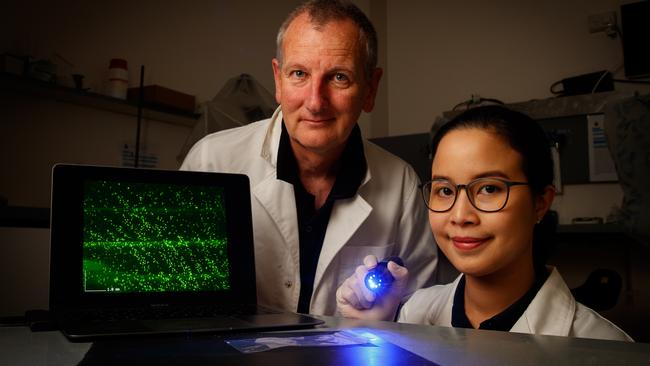Flinders University research making DNA evidence visible using a portable microscope
Drug dealers and users beware, forensic scientists now have a better way to collect DNA evidence from those plastic zip-lock bags, thanks to Flinders University research.
Tertiary
Don't miss out on the headlines from Tertiary. Followed categories will be added to My News.
- Sherlock 2.0: the Future of Forensics is here
- How to get the most out of your Advertiser subscription
Crime scene investigators are using Flinders University research to make DNA visible so they can gather stronger evidence for use in court.
Young researcher Piyamas Kanokwongnuwut developed the new technique, which is a quick and easy way to locate DNA within a few minutes.
A special dye makes the DNA visible under a handy portable microscope. It glows, showing investigators where to take samples.
“When you touch something, you leave DNA on the item,” she said. “Normally the forensic examiner doesn’t see it by the naked eye, they just guess where it should be, but they never see it.
“My technique uses a fluorescent nucleic acid dye named Diamond Dye, which is specific to DNA, then after we stain with this dye we can look under the microscope … the touch DNA is glowing and then the examiner can collect it easily.”
Originally from Thailand, the PhD candidate is winning an award this week for Best Higher Degree by Research Student Publication.
“It means a lot to me because we put a lot of effort into this and it shows that I’m on the right track,” she said.
“It’s nice to be recognised.”
The paper “Shedding light on shedders” was published in the journal Forensic Science International: Genetics in 2018 and has already been cited by other researchers 50 times.
It explains that people shed DNA at different rates. Some, like her supervisor Professor Adrian Linacre leave more DNA behind when they touch and are heavy shedders, while others like Ms Kanokwongnuwut are light shedders.

Ms Kanokwongnuwut is the lead author on ten journal articles and co-author on four more, bringing her total to 14.
Topics include the speed of accumulation of DNA in a fingermark, detection of cellular material in lip-prints or hand prints, and comparisons of different materials used for collecting samples such as tapes or swabs.
She has also explored the use of her technique in wildlife investigations.
Forensic Science SA is trialling the DNA detection technique to guide sampling from plastic zip-lock bags that drug dealers often use.
Director Chis Pearman says the team is pleased to be involved in the research.
“We are still gathering data but the results to date look promising,” he said.
“This technology has the potential to assist us significantly in detecting areas where we can take a usable sample to develop a DNA profile. The testing process is both costly and time-consuming, and being able to identify these areas simply and quickly would be of great benefit.”

